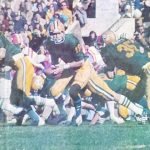SALT LAKE CITY — Remediation work began Wednesday to turn 770 acres of landfill in Salt Lake City’s Northwest Quadrant into an advanced manufacturing hub for the Utah Inland Port.
It was already over 80 degrees at the North Temple Landfill site when an excavator tore into the earth, releasing an acrid stench as the remains of half-century-old refuse was exhumed. A small rainbow was cast in the trench as mist from jet-black leachate poured in from the surrounding waste.
The site isn’t much to look at now — at least 660 acres of land north of I-80 between 5600 West and 7200 West have waste buried between 4 and 16 feet deep — but Utah Inland Port Authority officials envision the land as an “epicenter” of manufacturing and future “economic engine” for the entire state.
“We’re going to start remediating, and we’re not going to stop remediating. We’re not going to develop until we stop,” said Abby Osborne, chairwoman of the port authority. “We’re on the edge of … the Great Salt Lake. We all know how important it is to this ecosystem and to this valley, and we’re going to make sure we do everything to protect it. … We’re not going to stop until we get it done.”
That future remains a way off — remediation of the full site could take seven years as crews concentrate the tons of waste into a smaller landfill, preparing the rest of the land to be developed.
The future development will be paved with the literal wreckage of an old Salt Lake City landmark: the ZCMI Center that was torn down in 2007 to make way for the City Creek Center. Two large piles of concrete from that demolition sit alongside the road near 7200 South, awaiting being crushed into road base for the hub.
Workers have already found newspapers from the 1960s and a West High School yearbook from when the late Larry H. Miller was a student, but they may also encounter toxic chemicals and asbestos.
Ben Hart, the executive director of the Utah Inland Port Authority, said the cleanup and development of the land is hoped to be a boon to the west side of the valley.
“Today really is about a historic pivot day for this site,” he said. “This site has been used as a landfill for a lot of years, a lot of decades. Obviously, it has not recently, but its more recent use has been trying to get this cleaned up and put back into an economic position of strength for this west side of Salt Lake County and also for the state of Utah.”
State Sen. Jerry Stevenson, R-Layton, addressed the criticism of the port and the controversies it has created — it has drawn protests since its inception, and environmental groups have sued over the authority’s makeup — saying the pushback “has been not all bad” because it has forced the project to improve.
“I think we look back in 40 years — those of you that are around in 20 years, I may not be here — but I think we’ve got a great opportunity here. This is incredible what’s been done,” he said.
Victoria Petro, who represents much of the west side on the Salt Lake City Council, said the community has “always undergirded not just the city but the entire state.”
“We have literally handled everyone’s trash in perpetuity, and now we are going to take that legacy, we’re going to remediate it … and we are going to build something that offers the next generation of people who live in my neighborhood the opportunity to live the American Dream,” she said.
The Key Takeaways for this article were generated with the assistance of large language models and reviewed by our editorial team. The article, itself, is solely human-written.











